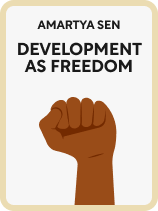

This article is an excerpt from the Shortform book guide to "Development as Freedom" by Amartya Sen. Shortform has the world's best summaries and analyses of books you should be reading.
Like this article? Sign up for a free trial here .
What are the economic reasons behind empowering women? What benefits do women gain through basic human rights and education?
In Development as Freedom, Amartya Sen claims that a bias against women is holding developing countries back from growing socially and economically. By giving women the freedom to pursue an education and have a job, they have the power to change communities or nations.
Let’s look at the importance of women’s economic empowerment in any part of the world.
Women’s Agency
Sen identifies bias against women as a major obstacle to growth in developing countries. This bias deprives women of basic rights in areas such as political participation and family planning. It also harms economic development by failing to tap into the productive capacity of women by excluding them from education and the workforce. By increasing women’s economic empowerment, Sen argues, not only are women better off, but their communities become safer and more prosperous.
Sen says the fix to gender bias is to improve women’s agency (their ability to make their own decisions in pursuit of their goals).
When women are free to choose whether to pursue an education, enter the workforce, or have children, they usually make choices that benefit not only themselves but their families and communities. This is because they are better equipped than the government to understand the implications of these choices on the people around them. When afforded the same opportunities as men, Sen contends that women become agents of change who can transform communities and societies for the better.
Prioritizing Women’s Rights
Sen argues that higher incomes don’t necessarily lead to advances in women’s rights. Research from the Word Bank group supports Sen’s belief and indicates that higher incomes were not associated with more women’s rights in the areas of property ownership or legal agreements.
However, two social factors were associated with improved women’s rights. Adopting international human rights agreements and having more women in the political office were linked to women’s rights of other kinds. These findings appear to corroborate Sen’s view that proactive measures must be taken to expand freedom for women, rather than relying on economic growth.
Women’s Economic Empowerment and Child Welfare
Sen argues that the most effective way to support women’s economic empowerment is to increase literacy. Research shows that increases in female literacy are strongly associated with a reduction in child mortality. This is because the knowledge women gain through education allows them to better care for their children.
In addition to reducing overall child mortality, female literacy (and female labor force participation) is also associated with closing the gap in mortality rates between boys and girls.
Other factors, such as male literacy and urbanization, weren’t associated with such reductions. This dynamic highlights Sen’s point that traditional methods of development don’t always lead to the desired results.
In this case, overall economic development was not enough to reduce child mortality, but women’s literacy was. For example, one study in India showed that a 50% reduction in the overall poverty rate made almost no difference in under-5 child mortality rates, but an increase in female literacy from 22% to 75% reduced child mortality rates from 156 per thousand births to 110 per thousand births.
Women’s Economic Empowerment and Fertility Rates
The benefits of female literacy and labor force participation have a similar positive effect on fertility rates. Around the globe, according to Sen, greater recognition of women’s rights usually leads to a reduction in fertility rates (the average number of children born per woman).
In many developing societies, women have little choice in family planning. Education gives women greater knowledge about family planning, and work outside the home often gives them more options, too.

———End of Preview———
Like what you just read? Read the rest of the world's best book summary and analysis of Amartya Sen's "Development as Freedom" at Shortform .
Here's what you'll find in our full Development as Freedom summary :
- The five types of freedom that are integral to economic development
- How democracy can prevent famine
- How empowering women helps communities






